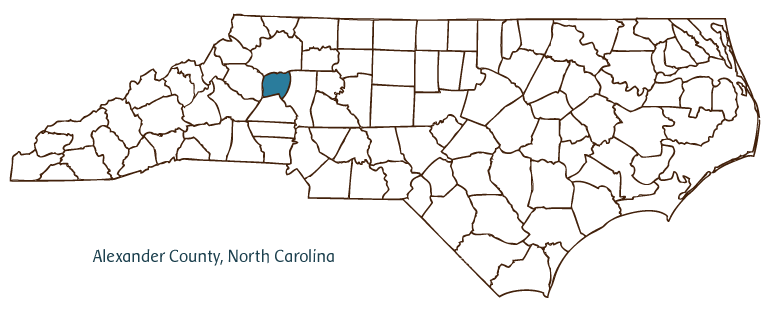Alexander County Resources
- View All:
- Biographies
- Monuments
- locations
Copyright Notice: This article is from the Encyclopedia of North Carolina edited by William S. Powell. Copyright © 2006 by the University of North Carolina Press. Used by permission of the publisher. For personal use and not for further distribution. Please submit permission requests for other use directly to the publisher.

Alexander County, located in the western Piedmont region, was formed from sections of Caldwell, Iredell, and Wilkes Counties in 1847. The county took its name from William Julius Alexander, Speaker of the North Carolina House of Commons. Taylorsville, the county seat, was named for either John Louis Taylor, the first chief justice of the North Carolina Supreme Court, or U.S. president Zachary Taylor. Other communities of note in the county include Hiddenite, Stony Point, Bethlehem, Ellendale, Little River, and Millersville.
Approximately two-thirds of Alexander County is farmland. Although agriculture employs only a small segment of the county's population (most jobs are provided by the manufacturing and service sectors), agricultural production remains strong. The county ranks third in the state for its poultry output, fifth in apples (apples produced in the county won first prize at the 1900 Paris World's Fair), sixth in dairy products, and tenth in beef cattle.
Alexander County is home to a wide variety of minerals. The Hiddenite Gems Emerald Hollow Mine is rich with emeralds, sapphires, garnets, aquamarine, smoky and clear quartz, tourmaline, sillimanite, monazite, and rutile. In 1969 the largest emerald in North America (subsequently given the name "Carolina") was unearthed in Hiddenite. The town also hosts the Hiddenite Celebration of the Arts, which features an eclectic program of musical performances. Other Alexander County events include the Apple Festival, the Taylorsville Lions Club Agricultural Fair, Stony Point Day, Mayfest, and the Vashti Fourth of July Parade. Alexander County had an estimated population of 35,000 in 2004.
For an annotated history of the county's formation, with the laws affecting the county, boundary lines and changes, and other origin information, visit these references in The Formation of the North Carolina Counties (Corbitt, 2000), available online at North Carolina Digital Collections (note, there may be additional items of interest for the county not listed here):
County formation history: https://digital.ncdcr.gov/Documents/Detail/the-formation-of-the-north-ca...
Index entry for the county: https://digital.ncdcr.gov/Documents/Detail/the-formation-of-the-north-ca...
References:
Sara C. Allen, ed., The Heritage of Alexander County, North Carolina (1985).
Additional resources:
Corbitt, David Leroy. 2000. The formation of the North Carolina counties, 1663-1943. https://digital.ncdcr.gov/Documents/Detail/the-formation-of-the-north-carolina-counties-1663-1943/3692099?item=4553233 (accessed June 20, 2017).
Alexander County Government: https://alexandercountync.gov/
DigitalNC, Alexander County: https://www.digitalnc.org/counties/alexander-county/
North Carolina Digital Collections (explore by place, time period, format): https://digital.ncdcr.gov
Image credits:
Rudersdorf, Amy. 2010. "NC County Maps." Government & Heritage Library, State Library of North Carolina.
Vocci, Robert Blair. "Alexander County." NCpedia. State Library of NC. 2006. https://www.ncpedia.org/geography/alexander.